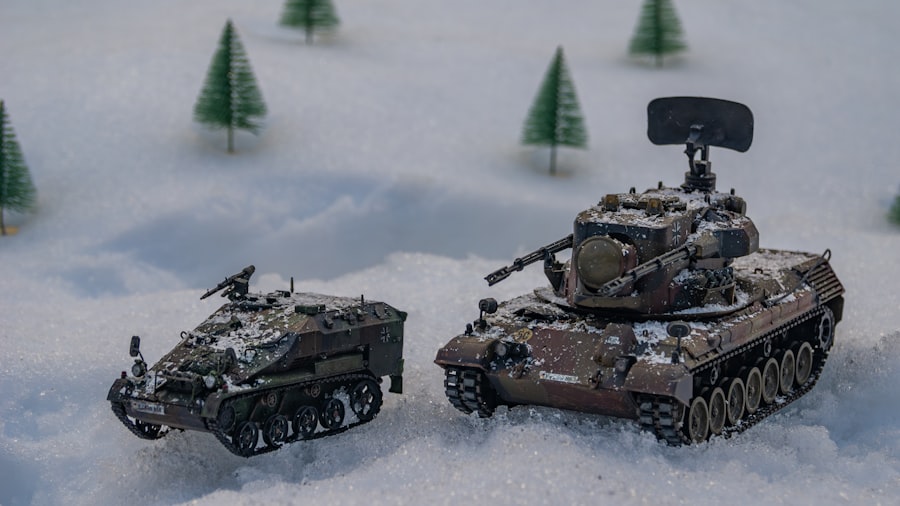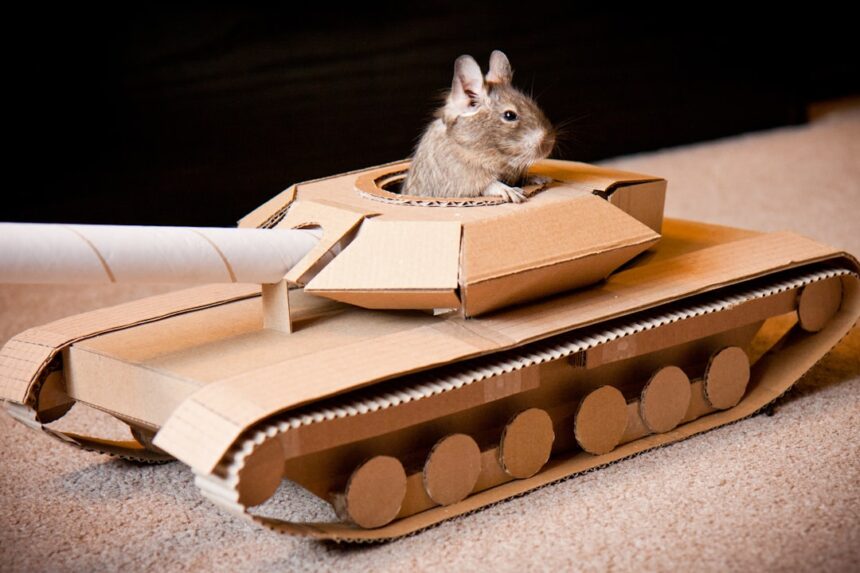Armored warfare has long been a pivotal aspect of military strategy, evolving from the rudimentary use of armored vehicles in World War I to the sophisticated systems seen on modern battlefields. The introduction of tanks and armored personnel carriers revolutionized ground combat, providing forces with enhanced mobility, protection, and firepower. This transformation not only changed the dynamics of warfare but also influenced tactics, logistics, and the overall structure of military forces.
As nations continue to invest in armored capabilities, understanding the historical context and current trends in armored warfare becomes essential for grasping its future trajectory. The significance of armored warfare extends beyond mere battlefield tactics; it embodies a complex interplay of technology, strategy, and human ingenuity. The development of armored vehicles has often mirrored advancements in engineering and materials science, leading to innovations that have redefined combat scenarios.
As conflicts evolve and new threats emerge, the role of armored vehicles remains crucial, necessitating ongoing research and development to ensure that military forces can effectively respond to contemporary challenges.
Key Takeaways
- Armored warfare has evolved significantly over the years, with advancements in technology and weaponry shaping the design and capabilities of armored vehicles.
- The evolution of armored vehicles has seen a shift towards lighter, more agile platforms with increased protection and firepower, allowing for greater mobility and versatility on the battlefield.
- Advancements in armor and protection have led to the development of composite materials and reactive armor, enhancing the survivability of armored vehicles against modern threats.
- Innovations in weaponry and firepower have resulted in the integration of advanced systems such as remote weapon stations, guided missiles, and electromagnetic railguns, increasing the lethality of armored vehicles.
- The integration of autonomous and unmanned systems, as well as artificial intelligence, is shaping the future of armored warfare, with a focus on enhancing situational awareness, decision-making, and operational effectiveness.
The Evolution of Armored Vehicles
The journey of armored vehicles began in the early 20th century, with the first tanks making their debut during World War
These early machines were designed to break through entrenched positions and navigate the treacherous terrain of the Western Front. Their introduction marked a significant shift in military doctrine, as commanders began to recognize the potential of mechanized warfare. Over the decades, armored vehicles underwent significant transformations, adapting to the changing nature of warfare and technological advancements.

By World War II, tanks had evolved into formidable weapons of war, with designs that prioritized speed, firepower, and armor thickness. The iconic Sherman and Tiger tanks exemplified this evolution, showcasing different philosophies in armored warfare. The post-war period saw further innovations, with the Cold War spurring an arms race that led to the development of more advanced tanks like the M1 Abrams and T-80.
Each iteration reflected not only technological advancements but also shifts in military strategy and geopolitical considerations.
Advancements in Armor and Protection
| Advancements | Benefits |
|---|---|
| Nanotechnology in armor | Enhanced strength and flexibility |
| Composite materials | Lightweight and durable protection |
| Smart armor technology | Real-time threat detection and response |
| Improved ballistic resistance | Enhanced protection against firearms |
As armored vehicles became central to military operations, advancements in armor technology became paramount. Early tanks relied on steel plating for protection, but as anti-tank weaponry evolved, so too did the materials used in armor construction. The introduction of composite armor, which combines different materials to enhance protection while reducing weight, marked a significant leap forward.
This innovation allowed for greater mobility without sacrificing defensive capabilities. In recent years, the focus has shifted towards active protection systems (APS) that can detect and neutralize incoming threats before they reach the vehicle. These systems utilize a combination of sensors and countermeasures to intercept projectiles, providing an additional layer of defense.
The integration of reactive armor, which explodes outward upon impact to deflect incoming rounds, further exemplifies the ongoing quest for enhanced protection in armored warfare. As threats become more sophisticated, the development of armor technology continues to be a critical area of research.
Innovations in Weaponry and Firepower
The evolution of armored vehicles is closely tied to advancements in weaponry and firepower. Early tanks were equipped with machine guns and cannons that were effective against infantry and light vehicles but struggled against fortified positions. As warfare progressed, so did the armament of armored vehicles.
The introduction of larger caliber guns and guided missile systems transformed tanks into formidable adversaries capable of engaging a wide range of targets. Modern armored vehicles are often equipped with advanced targeting systems that enhance accuracy and lethality. The integration of fire control systems allows crews to engage targets at greater distances with precision.
Additionally, the development of unmanned aerial vehicles (UAVs) has provided commanders with real-time intelligence, enabling them to make informed decisions about when and how to engage enemy forces. This synergy between weaponry and technology has redefined the capabilities of armored units on the battlefield.
The Role of Technology in Armored Warfare

Technology plays a crucial role in shaping the landscape of armored warfare. From communication systems that facilitate coordination among units to advanced navigation tools that enhance mobility, technological innovations have transformed how armored forces operate. The integration of digital systems allows for seamless information sharing, enabling commanders to make strategic decisions based on real-time data.
Moreover, simulation technologies have revolutionized training for armored units. Virtual reality and augmented reality systems provide soldiers with immersive training experiences that prepare them for various combat scenarios without the risks associated with live exercises. This technological advancement not only enhances readiness but also fosters adaptability among troops as they learn to operate complex systems in dynamic environments.
Future Trends in Armored Vehicle Design
As military needs evolve, so too do the designs of armored vehicles. Future trends indicate a shift towards modularity and versatility in vehicle design. Modular platforms allow for easy upgrades and modifications, enabling forces to adapt their vehicles to specific mission requirements without the need for entirely new designs.
This flexibility is particularly important in an era where threats can vary significantly from one conflict to another. Additionally, there is a growing emphasis on reducing the logistical footprint of armored units. Lightweight materials and hybrid propulsion systems are being explored to enhance fuel efficiency and reduce maintenance requirements.
As environmental concerns become increasingly prominent, manufacturers are also focusing on developing greener technologies that minimize the ecological impact of armored vehicles while maintaining operational effectiveness.
The Impact of Autonomous and Unmanned Systems
The rise of autonomous and unmanned systems is poised to revolutionize armored warfare in unprecedented ways.
These systems can operate in environments that may be too dangerous for manned vehicles, providing commanders with valuable intelligence while minimizing casualties.
Moreover, autonomous systems can enhance situational awareness on the battlefield by processing vast amounts of data from various sensors and relaying critical information to human operators. This capability allows for quicker decision-making and more effective responses to emerging threats.
The Integration of Artificial Intelligence in Armored Warfare
Artificial intelligence (AI) is increasingly becoming a cornerstone of modern military operations, including armored warfare. AI algorithms can analyze data from multiple sources—such as satellite imagery, drone feeds, and battlefield sensors—to provide actionable insights for commanders. This capability enhances situational awareness and enables more informed decision-making during combat operations.
Furthermore, AI can be utilized in training simulations to create realistic scenarios that challenge soldiers’ decision-making skills under pressure. By incorporating machine learning techniques, these simulations can adapt based on individual performance, ensuring that troops are better prepared for real-world engagements. As AI technology continues to evolve, its integration into armored warfare will likely lead to more efficient operations and improved outcomes on the battlefield.
Environmental Considerations in Armored Vehicle Development
In recent years, environmental considerations have gained prominence in the development of armored vehicles. As militaries around the world grapple with climate change and its implications for national security, there is a growing recognition of the need for sustainable practices within defense industries. This includes exploring alternative fuels and energy sources that reduce carbon emissions associated with traditional diesel-powered vehicles.
Additionally, manufacturers are increasingly focused on designing vehicles that minimize their ecological footprint throughout their lifecycle—from production to disposal. This shift not only addresses environmental concerns but also aligns with broader societal expectations regarding corporate responsibility. As defense budgets face scrutiny amid calls for sustainability, integrating environmental considerations into armored vehicle development will become essential for future military planning.
The Future of Urban Warfare and Armored Vehicles
Urban warfare presents unique challenges for armored vehicles due to the complexities of operating in densely populated environments. As cities become battlegrounds in modern conflicts, the design and deployment of armored units must adapt accordingly. Future armored vehicles may prioritize agility and maneuverability over sheer firepower to navigate narrow streets and avoid collateral damage.
Moreover, urban environments require enhanced situational awareness capabilities to identify threats hidden among civilians or infrastructure. Advanced sensor technologies and AI-driven analytics will play a crucial role in enabling armored units to operate effectively within these challenging contexts. As urban warfare continues to evolve, so too will the strategies employed by military forces utilizing armored vehicles.
The Outlook for Armored Warfare
The future of armored warfare is poised for significant transformation as technological advancements reshape military capabilities and strategies. From innovations in armor protection to the integration of AI and autonomous systems, the landscape of combat is evolving rapidly. As nations adapt their armed forces to meet emerging threats and challenges, understanding these trends will be crucial for maintaining operational effectiveness.
Ultimately, while the core principles of armored warfare remain rooted in mobility, protection, and firepower, the methods by which these principles are realized will continue to change dramatically. As militaries embrace new technologies and adapt their strategies accordingly, the outlook for armored warfare remains dynamic—reflecting both historical lessons learned and future possibilities yet to be explored.
In exploring the future of armored warfare, it’s essential to consider the evolving dynamics of military technology and strategy. A related article that delves into these themes can be found on the website “In The War Room.” This article provides insights into how advancements in technology are reshaping the battlefield and the role of armored units. For a deeper understanding of these developments, you can read more about it by visiting In The War Room. This resource offers a comprehensive analysis of current trends and future projections in armored warfare, making it a valuable read for anyone interested in military strategy and technology.
FAQs
What is armored warfare?
Armored warfare refers to the use of armored vehicles, such as tanks and armored personnel carriers, in military operations. These vehicles are equipped with armor and weapons to provide protection and firepower on the battlefield.
What is the future of armored warfare?
The future of armored warfare is likely to involve advancements in technology, such as improved armor materials, more powerful weapons systems, and increased automation and connectivity. Additionally, there may be a greater emphasis on mobility and versatility to adapt to changing battlefield conditions.
How will technology impact armored warfare in the future?
Technology is expected to have a significant impact on armored warfare, with developments in areas such as unmanned vehicles, advanced sensors and targeting systems, and enhanced communication and networking capabilities. These advancements are likely to improve the effectiveness and survivability of armored units on the battlefield.
What are some challenges facing the future of armored warfare?
Challenges facing the future of armored warfare include the need to adapt to unconventional and urban warfare environments, as well as the potential for adversaries to develop advanced anti-armor capabilities. Additionally, there may be logistical and cost challenges associated with maintaining and operating advanced armored vehicles.
How will armored warfare adapt to changing security threats?
Armored warfare is likely to adapt to changing security threats by incorporating new technologies and tactics to counter emerging threats, such as unmanned and asymmetric warfare. This may involve the development of more agile and versatile armored vehicles, as well as enhanced training and coordination with other military assets.




